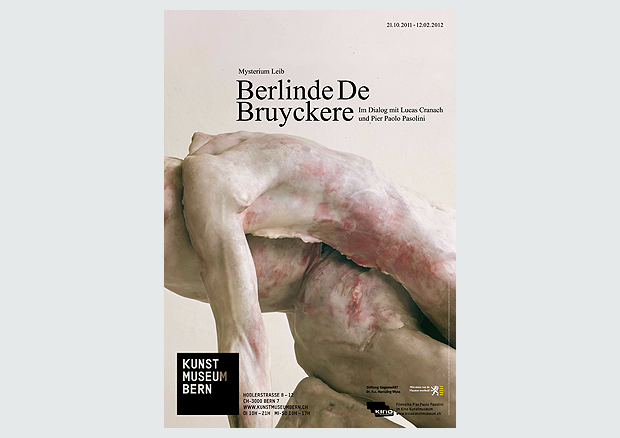The Mystery of the Body: Berlinde De Bruyckere in Dialogue with Lucas Cranach and Pier Paolo Pasolini, 21.10.2011 - 12.02.2012
The Intrepid Search for Proximity to Suffering
The Kunstmuseum Bern is presenting the largest monographic exhibition of works by Berlinde De Bruyckere (b. 1964) hitherto shown in Europe. The Flemish artist creates deceptively real sculptures and touching drawings of human bodies suffering. The presentation brings them into a dialogue with the works of the German Renaissance painter Lucas Cranach and the Italian film maker Pier Paolo Pasolini.
The human body is one of the most commonly portrayed subjects, and each
generation of artists interprets it anew. The exhibition lucidly
illustrates Berlinde De Bruyckere's in-depth examination of Lucas
Cranach's and Pier Paolo Pasolini's work over the past three years.
New existentialism in contemporary art
We not only find De
Bruyckere’s representations of suffering human beings shocking because
of their directness but likewise deeply moving. In her existential
representations of suffering she unites elements of pain as well as of
lust, shame, and grief. The artist evokes a confusion of feelings in us
that oscillates between disgust and dismay. In doing so, De Bruyckere
underscores the essentially human – namely that we all possess a body.
The artist takes a stand in opposition to the event industry and the
beauty market. Contrary to the ideal images used in advertising, her
sculptures of bodies do not hide their scars and sutures. Instead they
highlight the body’s vulnerability. Her works make us conscious of the
fact that our bodies are vulnerable and immortal. Awareness for this is
rapidly diminishing in a world in which practically every nook and
cranny has been infiltrated by the new media. De Bruyckere successfully
moves her viewers into feeling real sympathy for her sculptures without
pandering to voyeurism.
Putting society under political and critical scrutiny
Lucas Cranach still embedded the theme of suffering in a religious context. His masterly Schmerzensmann (Man of Sorrows) presents the scourged figure of Christ wearing a crown of thorns to
arouse our pity and bring us to reflect on religion. Cranach depicts
Christ as a man who suffers, not as God, and thereby circumvents
ecclesiastical ideology. De Bruyckere adopts the motif of suffering and
adapts it to the present. With it she critically questions modern
society and thereby takes a political stance in her work. In this way
she resembles Pier Paolo Pasolini. For the Italian film maker the human
body was not only an arena for staging individuality, sensuousness, as
well as insatiable and uncontrollable drives, but also for sexual and
violent excessiveness. Pasolini views the body as a focal point in the
fight against petty bourgeois social order, in which he not only saw the birth of Fascism but also the foundations of consumer society.
A dialogue transcending media and time
The exhibition presents a transmedia dialogue between sculptures, drawings, paintings, and
films. However, the dialogue not only brings together various media but
also spans many epochs. The show visually demonstrates how the body has
always been a “mystery” in the sense that it can never be comprehended
fully. Every one of us is challenged to confront this fact. The exhibition is a collaborative project together with Cornelia Wieg and the Stiftung Moritzburg — Kunstmuseum des Landes Sachsen-Anhalt, where it was shown from April 3 to July 3, 2011.


